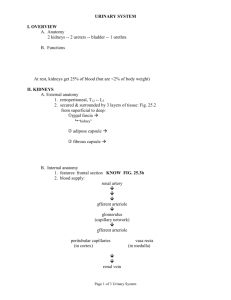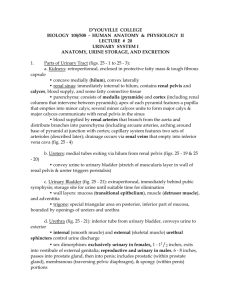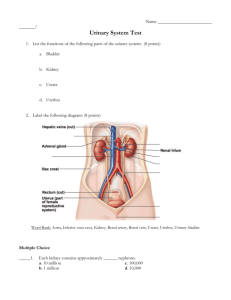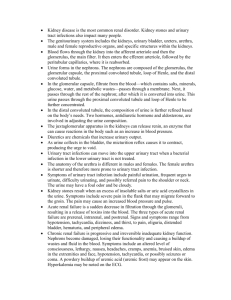Urinary system Lab Guide
advertisement
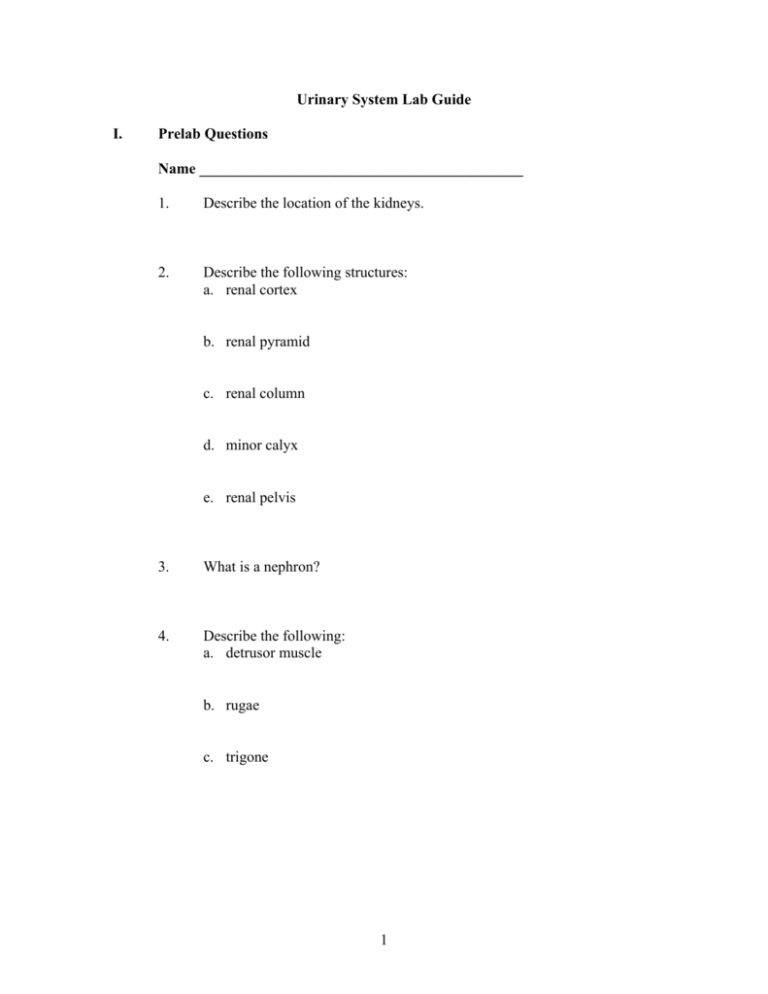
Urinary System Lab Guide I. Prelab Questions Name ___________________________________________ 1. Describe the location of the kidneys. 2. Describe the following structures: a. renal cortex b. renal pyramid c. renal column d. minor calyx e. renal pelvis 3. What is a nephron? 4. Describe the following: a. detrusor muscle b. rugae c. trigone 1 II. Exercises: The objective of this lab is to learn urinary anatomy from: A. A short lecture on gross and microscopic urinary anatomy. B. Illustrations from this manual, your textbook, handouts, lab charts and the Anatomy and Physiology Coloring Book, if you wish to purchase it. C. Models: 1. Urinary System 2. Kidney 3. Nephron 4. Renal corpuscle D. Dissection of a pig kidney. E. A.D.A.M. Interactive Anatomy software. F. Use of microscope slides to learn urinary histology (optional). 1. Organs of the urinary system: Use figures 26.1 in your text and the urinary system model to reinforce your learning of the structures labeled on these figures. Identify the following structures: ♦The kidneys (1) are bean shaped organs that form the waste product called urine. They are located in the upper lumbar region between the level of the twelfth thoracic and third lumbar vertebrae. The kidneys are sandwiched between the posterior abdominal cavity and the parietal peritoneum. This position is referred to as retroperitoneal. Each kidney is approximately 5” long, 2.5” wide, and 1” thick. Why is right kidney is slightly lower than the left? ♦Blood enters the kidney through the renal artery (2), and exits through the renal vein (3). ♦Urine passes from each kidney to the urinary bladder (4) through tubes called ureters (5). ♦The urinary bladder, located in the pelvic cavity, provides for temporary storage of urine. ♦Urine exits the urinary bladder through a single tube called the urethra (6). 2 Figure 1. Urinary System Model 3 2. The anatomy of the kidney: Use figure 26.3 in your text and the models of the kidney to identify the following structures: ♦A fibrous renal capsule (7) encloses each kidney. ♦The renal cortex (8) is the outer region of the kidney where most urine formation occurs. The cortex looks granular because of all of the blood vessels and nephrons in it. ♦Deep to the cortex is the renal medulla (9). The medulla consists of renal pyramids (10). The kidney model shows the pyramids as dark, triangular structures with their bases bordering the cortex and their points (apices) pointing toward the center of the kidney. Pyramids are filled with urine collecting tubules; that is why they look striated. The point or apex of a pyramid is a renal papilla (11). Cortical tissue extends inward between the pyramids to form renal columns (12). Blood vessels pass through the columns to get to and from the cortex. ♦The papilla of each pyramid fits into a funnel-like structure called the minor calyx (13). Urine drains from the papilla of the pyramid into the minor calyx. ♦Several minor calices (calices is plural for calyx) merge to form a major calyx (14). ♦Two to three major calices merge to form the renal pelvis (15). Urine collects in the pelvis before exiting the kidney. ♦Urine drains from the pelvis into a tube called the ureter. The ureter transports urine from the kidney to the urinary bladder. ♦ The hilus (16) is a prominent indentation on the medial side of the kidney; it is the point of entry for the renal artery and the point of exit for the renal vein and the ureters. ♦The renal capsule turns inward at the hilus and lines an internal cavity called the renal sinus (17). The calices, renal blood vessels, and adipose tissue fill the sinus. The best view of the renal sinus is in ADAM Interactive Anatomy. 3. Kidney Circulation: Use figure 26.4 in your text and the kidney model to learn kidney circulation. This does not include nephron circulation; it is covered later. You must know the following kidney vessels: ♦renal artery (2) ♦segmental artery (18) ♦interlobar artery (19) ♦arcuate artery (20) ♦interlobular artery (21) ♦interlobular vein (22) ♦arcuate vein (23) ♦interlobar vein (24) ♦renal vein (3) 4 Figure 2. Kidney Model 5 Match the numbers in the kidney drawing with the name of the structure. _______renal cortex _______renal papilla _______renal column _______renal pelvis _______renal pyramid (medulla) _______minor calyx _______ureter _______renal capsule _______major calyx Figure 3. Kidney Drawing 6 4. Pig kidney dissection: 1. Examine the outside of a pig kidney and identify the renal capsule, ureter, renal artery and the renal vein. 2. Using a large knife, make a mid-coronal section through the kidney as shown below: Examine each half of the bisected kidney and decide which is the best for Identification of structures. Identify the following structures; referring to figure 26-4 in your text. ♦renal cortex ♦renal medulla consisting of renal pyramids ♦papilla of the renal pyramid ♦renal columns ♦minor calyx ♦major calyx ♦renal pelvis ♦ureter 7 5. The anatomy of the nephron The renal cortex of each kidney contains about 1.25 million microscopic filtering units called nephrons (25). Nephrons consist of microscopic tubules and microscopic blood vessels. A nephron looks sort of like a coiled snake. Use figures 26.5, 26.6, and 26.8 in your text, and the two models of the nephron to learn the anatomy of the nephron. ♦ The first part of the nephron is a bulbous part called the renal corpuscle (26). If the nephron looks like a snake, the renal corpuscle looks like the head of the snake. The renal corpuscle consists of a weird ball of porous capillaries called the glomerulus (27) that is enclosed by a hollow structure called the Bowman’s capsule (28). The capsule surrounds the glomerulus like a ball in a catcher’s mitt. The Bowman’s capsule is double-layered. The outer, smoother layer of cuboidal cells is the parietal layer (29). The inner visceral layer (30) is composed of cells called podocytes (31). The podocytes have vine-like extensions that wrap around the glomerular capillaries forming filtering slits. A cavity called the capsular space (32) is located between the parietal and visceral layers of the Bowman’s capsule. Blood is supplied to the glomerulus by the afferent arteriole (33), and is collected from the glomerulus by the efferent arteriole (34). When blood enters the glomerulus, some of its fluid is filtered through the filtration slits into the capsular space. The fluid entering the capsular space is called filtrate. Filtrate consists of waste and many substances that we need to keep. The nephron tubules change the filtrate into the waste product called urine by keeping the useful substances and eliminating the wastes. ♦The first of the nephron tubules is a twisted tube called the proximal convoluted tubule (PCT) (35). The PCT gets its name because it is closest (proximal) to the renal corpuscle and because it is twisted (convoluted). ♦After the PCT, the nephron tubule turns sharply toward the medulla and becomes the loop of Henle (36). The loop descends down into the medulla, makes a hairpin turn, and then ascends back up into the cortex. The descending part is the descending limb (37) and the ascending part is the ascending limb (38). The upper part of each limb is composed of cuboidal cells, and is called the thick segment (39). The lower part of each limb is composed of squamous cells, and is called the thin segment. The loop of Henle plays an important role in regulating urine volume. This process will be studied in more detail in lecture. ♦After the loop of Henle, the nephron tubule becomes the distal convoluted tubule (DCT) (40). The DCT is the last part of the nephron. ♦Each nephron connects to a tubule called a collecting duct (41). Each collecting duct connects to several nephrons, and then descends down through the pyramid (medulla). In the papilla of the pyramid, several collecting ducts merge to form a papillary duct (42). In each renal papilla, several hundred papillary ducts drain urine into a minor calyx. 8 Peritubular Capillaries Vasa Recta Figure 4. Nephron Model 9 Figure 5. Renal Corpuscle Model 10 Match the numbers in the nephron drawing with the name of the structure. ______distal convoluted tubule (DCT) ______collecting duct ______glomerulus ______efferent arteriole ______proximal convoluted tubule (PCT) ______afferent arteriole ______descending limb of loop of Henle ______Bowman’s capsule ______ascending limb of loop of Henle Figure 6. Nephron Drawing 6. Nephron circulation: Use figure 26.4 and 26.5 in your text, and the nephron models (figures 4&5 in this guide) for nephron circulation. You are responsible for the following vessels: ♦afferent arteriole ♦glomerulus ♦efferent arteriole ♦peritubular capillaries ♦vasa recta 11 7. The urinary bladder is a temporary reservoir that holds urine until it is eliminated (voided). Use figure 26.21 in your text and the model of the complete urinary system to identify the following: ♦The detrusor muscle (44) comprises most of the bladder wall. When this powerful muscle contracts it, squeezes urine out of the bladder. ♦The ureters (5) penetrate the posterior wall of the urinary bladder at an oblique angle and open into the bladders through a pair of ureteral orifices (openings) (46). ♦Above the ureteral openings, the bladder mucosa is thrown into folds called rugae (47). The rugae disappear when the bladder is full. ♦The bladder narrows at the bottom forming a neck (48). ♦The urethra (6) is a tube that transports urine from the neck of the bladder to the exterior. ♦Near the bottom of the urinary bladder, the two ureteral openings and the urethral opening form an upside down triangle called the trigone (49). The trigone serves as a “funnel” to direct urine into the urethra. The mucosa of the trigone is much smoother and thicker than the mucosa above it. ♦The internal urethral sphincter (50) is a circle of smooth (involuntary) muscle at the bladder neck. ♦The external urethral sphincter (51) is a circle of skeletal (voluntary) muscle surrounding the urethra in the pelvic floor. This sphincter provides voluntary control of our bladder. Figure 7. Urinary Bladder Model 12 Match the numbers in the urinary bladder drawing with the name of the structure. _____trigone _____urethra _____ureter _____opening of ureter _____rugae _____external urethral sphincter _____detrusor muscle _____bladder neck and internal urethral sphincter Figure 8. Urinary Bladder Drawing 13 8. Histology of the kidney: (optional) Use the Microscope slide labeled “kidney PAS & H sec” and figure 26-6 in your text to identify the following structures: ♦glomerulus ♦Bowman’s capsule ♦nephron tubules ADAM Interactive Anatomy-Urinary System Gross Anatomy of the Urinary System 1. Click on open dissectible anatomy tab. 2. Click on resizing icon to enlarge window. 3. Center the image over mid-abdomen. 4. Select layer #229 and identify the following: (a) Anterior layer of perirenal fat (b) left renal vein 5. Select layer #232 and identify the following: (a) left kidney (b) right kidney (c) ureter (d) hilum(hilus) of left kidney and hilum(hilus) of right kidney (e) right renal vein (f) left adrenal gland (g) right adrenal gland 6. Select layer #240 and identify the following: (a) right renal artery (b) left renal artery 7. Select layer #241 and identify the following: (a) renal cortex (b) renal pyramid of renal medulla (c) renal column (d) minor calyx (e) major calyx (f) renal pelvis (g) ureter 8. Select layer #243 and identify the renal sinus. 9. Select layer #211 and identify the following: (a) urinary bladder (b) ureter 14 The Nephron 1. Click on content. 2. Click on Atlas Anatomy tab. 3. Click on System radio button. 4. Select Urinary System. 5. Select Diagram of Nephron. 6. Click on open. 7. Identify the following: (a) glomerulus (b) afferent arteriole (c) efferent arteriole (d) proximal convoluted tubule (e) distal convoluted tubule (f) collecting tubule (duct) (g) peritubular capillaries (h) descending limb of Henle (i) ascending limb of Henle (j) vasa recta Urinary Focus Questions Identify structures from the following descriptions. 1. Name the artery that supplies blood to kidney. ______________________ 2. Name the vein that collects blood from the kidney. ______________________ 3. Name the kidney vessels that pass through the renal columns _________________________________________________ 4. Name the tube that collects urine from the kidney and carries it to the urinary bladder. _______________________ 5. Name the part of bladder where the urethra begins. ___________________________ 6. Name the folds in the urinary bladder. ______________________ 7. Give the name for the voluntary urinary sphincter. _____________________________ 8. Give the name for the bladder muscle ___________________________ 9. Name the triangular area between the ureteral orifices and the urethral orifice. _____________________ 10. Name the fibrous covering of kidney. ______________________ 15 11. Name the outer zone of kidney where nephrons are located. ______________________ 12. Name the arteries that extend up into the cortex and supply blood to afferent arterioles _____________________________ 13. Name the part of kidney that contains numerous tubules and ends in the renal papilla. ____________________________ 14. Name the smaller funnel-like structures that collect urine from renal papilla. ___________________________ 15. Name the larger channels that receive urine from above structures. __________________________ 16. Name the large central cavity that receives urine before it passes out of the kidney. _____________________________ 17. Name the depression on medial side of kidney through which structures enter and exit the kidney. _____________________ 18. Name the cavity just inside the above depression ___________________________ 19. Name the loops of capillaries inside Bowman's capsule. ____________________________________ 20. Name the small vessel that brings blood directly into above capillaries in question 19. ______________________________ 21. Name the small vessel that collects blood from the capillaries in question 19. _______________________________ 22. Name the first tube of the nephron that emerges from the Bowman's capsule. __________________________________ 23. Name the nephron tubule that extends down into the medulla and back up into the cortex. _________________________________ 24. Name the next tubule after tubules 23. ____________________________________________ 25. Name the channel that receives filtrate from above tube. It extends down though the inner layer of the kidney. ________________________________________ 26. Name the net-like mass of capillaries that wind all around the nephron tubules. _______________________ 16
